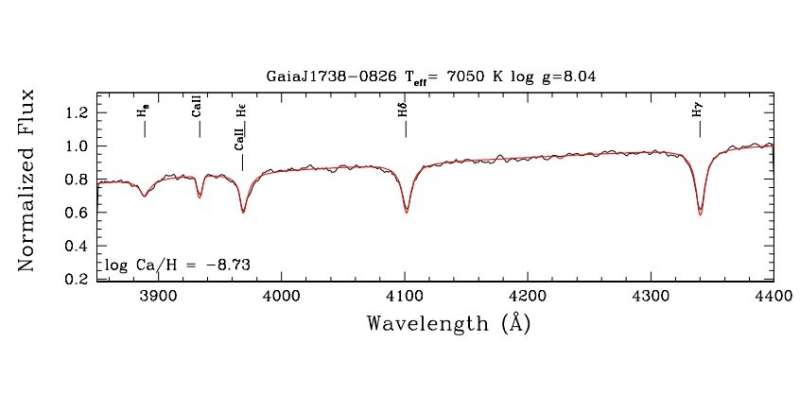July 4, 2018 report
First polluted white dwarf found in Gaia DR2

Astronomers have identified the first metal-polluted white dwarf star from the Gaia Data Release 2 (DR2) provided by ESA's Gaia satellite. The newly found star received designation GaiaJ1738−0826. The finding is detailed in a paper published June 24 on the arXiv pre-print repository.
DR2, published on April 25, provides high-precision measurements, including positions in the sky, parallaxes and proper motions for more than 1 billion sources in our galaxy. The release contains observational data collected by Gaia in the timespan of nearly two years – between July 25, 2014 and May 23, 2016.
Now, a team of astronomers led by Carl Melis of the University of California San Diego, has conducted spectroscopic observations of one white dwarf listed in the DR2 catalog. They employed the KAST spectrograph mounted on the Shane 3-m telescope at Lick Observatory in California to characterize this white dwarf. They found that this star exhibits strong absorption line of ionized calcium.
"We present the first metal-polluted single white dwarf (WD) star identified through Gaia DR2 (Brown et al. 2018). GaiaJ1738−0826 was discovered to have strong Ca II absorption in initial spectroscopic characterization at Lick Observatory," the astronomers wrote in the paper.
Observations conducted by Melis' team indicate that GaiaJ1738−0826 is a metal-polluted white dwarf star with a radius of 0.012 solar radii and a mass of 0.6 solar masses. It has an effective temperature of 7,050 K, luminosity of 3.3 percent of that of our sun and an estimated cooling time of about 1.7 billion years.
Furthermore, the researchers calculated that GaiaJ1738−0826 has a calcium mass accretion rate in steady-state of approximately 2,600 kilograms per second. This value indicates that GaiaJ1738−0826 could be accreting 160,000 kilograms every second, assuming that calcium makes up about 1.6 percent of the total heavy element accretion rate in this white dwarf.
The authors of the paper noted that the accreting rate at a level of 160,000 kilograms per second could indicate the presence of a circumstellar accretion disk around GaiaJ1738−0826. However, archival data from the VISTA Hemisphere Survey and NASA's Spitzer space telescope do not confirm this assumption.
According to the paper, GaiaJ1738−0826 resembles the first confirmed white dwarf of DAZ-type (displaying absorption features also from heavier elements), known as G 74−7. This DAZ white dwarf is similar in size, mass, luminosity, effective temperature and cooling time to GaiaJ1738−0826. It's calcium mass accretion rate was found to be at a level of around 1,500 kilograms per second.
"Notably, GaiaJ1738−0826 resembles in many ways the first confirmed metal-polluted hydrogen atmosphere WD, the DAZ G 74−7 (Lacombe et al. 1983)," the paper reads.
The researchers concluded that polluted white dwarfs like GaiaJ1738−0826 offer a glimpse into the fate of planetary systems and an unparalleled method of determining the composition of solid material in planetary systems. Moreover, such stars have been recently found very helpful in providing structural information for massive, differentiated rocky bodies.
More information: The first polluted white dwarf from Gaia DR2: the cool DAZ GaiaJ1738-0826, arXiv:1806.09056 [astro-ph.SR] arxiv.org/abs/1806.09056
Abstract
We present the first metal-polluted single white dwarf star identified through Gaia DR2. GaiaJ1738-0826, selected from color and absolute magnitude cuts in the Gaia DR2 data, was discovered to have strong Ca~II absorption in initial spectroscopic characterization at Lick Observatory. Notably, GaiaJ1738-0826 resembles in many ways the first confirmed metal-polluted hydrogen atmosphere white dwarf, the DAZ G74-7.
© 2018 Phys.org




















